[/caption]
What do NASA, Robots, the Sun and the NFL have in common ?
Well … its Super SUNday … for Super Bowl XLV on Feb. 6, 2011
The unlikely pairing of Football and Science face off head to head on Super Bowl SUNday. Millions of television viewers will see NASA’s Robonaut 2, or R2, share the the limelight with the Steelers and the Packers of the NFL. The twin brother of R2 is destined for the International Space Station (ISS) and will become the first humanoid robot in space. It will work side by side as an astronaut’s assistant aboard the space station.
The fearsome looking R2 is set to make a first ever special guest appearance during the FOX Networks Super Bowl pre-game show with FOX sports analyst Howie Long. The pre-game show will air starting at 2 p.m. EST on Feb. 6.
And there’s more.

The two STEREO spacecraft will reach positions on opposite sides of the Sun on Sunday, Feb. 6 at about 7:30 p.m. in the evening, possibly coinciding with the Super Bowl half time show.
At opposition, the STEREO duo will observe the entire 360 degrees sphere of the Sun’s surface and atmosphere for the first time in the history of humankind.
The nearly identical twin brother of R2 is packed aboard Space Shuttle Discovery and awaiting an out of this world adventure from Launch Pad 39 A at NASA’s Kennedy Space Center (KSC) in Florida. Blast off of the first humanoid robot is currently slated for Feb. 24.
R2 is the most dextrously advanced humanoid robot in the world and the culmination of five decades of wide-ranging robotics research at NASA and General Motors (GM).
This newest generation of Robonauts are an engineering marvel and can accomplish real work with exceptionally dexterous hands and an opposable thumb. R2 will contribute to the assembly, maintenance and scientific output of the ISS
“R2 is the most sophisticated robot in the world,” says Rob Ambrose, Chief of NASA’s Johnson Space Center’s (JSC) Robotics Division.
“We hope R2 should help to motivate kids to study science and space,” Ron Diftler told me in an interview at KSC. Diftler is NASA’s R2 project manager at JSC.
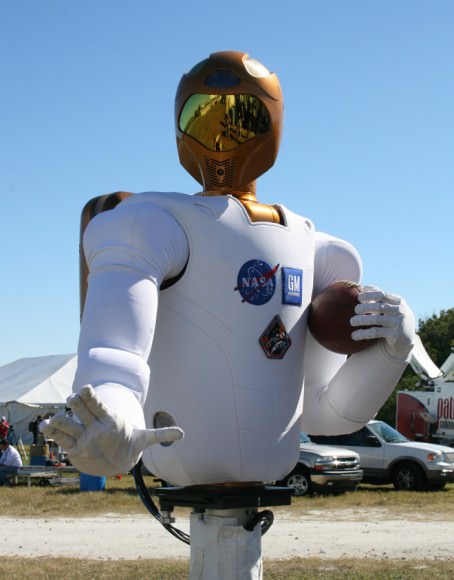
The amazingly dexterity of the jointed arms and hands enables R2 to use exactly the same tools as the astronauts and thereby eliminates the need for constructing specialized tools for the robots –saving valuable time, money and weight.
The robot is loaded with advanced technology including an optimized overlapping dual arm dexterous workspace, series elastic joint technology, extended finger and thumb travel, miniaturized 6-axis load cells, redundant force sensing, ultra-high speed joint controllers, extreme neck travel, and high resolution camera and IR systems.
R2 weighs some 300 pounds and was manufactured from nickel-plated carbon fiber and aluminum. It is equipped with two human like arms and two hands as well as four visible light cameras that provide stereo vision with twice the resolution of high definition TV.
“With R2 we will demonstrate ground breaking and innovative robotics technology which is beyond anything else out there and that will also have real world applications as GM works to build better, smarter and safer cars,” according to Susan Smyth, GM Director of Research and Development.
“Crash avoidance technology with advanced sensors is a prime example of robonaut technology that will be integrated into GM vehicles and manufacturing processes.”
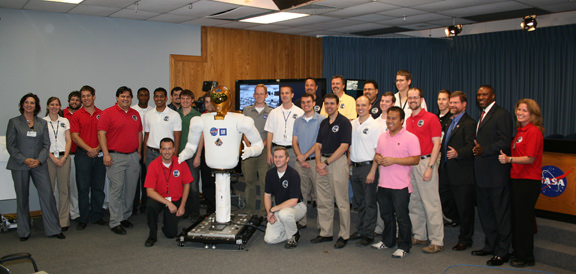
R2 will become an official ISS crew member. Credit: Ken Kremer
Robonaut 2 flight unit poses with the NASA/GM development team inside the Space Station Processing Facility at KSC in this 360 degree panorama from nasatech.net
I was fortunate to meet R2 and the Robonaut team at KSC. R2 is incredibly life like and imposing and I’ll never forget the chance to shake hands. Although its motions, sounds, illuminated hands and muscular chest gives the unmistakable impression of standing next to a lively and powerful 300 pound gorilla, it firmly but gently grasped my hand in friendship – unlike a Terminator.
So its going to make for a mighty match up some day between the fearsome looking R2 and the NFL players.
Well apparently, R2 and Howie will be making some predictions on which player will win the MVP award and a GM Chevrolet. Stay tuned.
So come back on SUNday Feb. 6 for NASA’s release of the first ever images of our entire Sun from the STEREO twins.
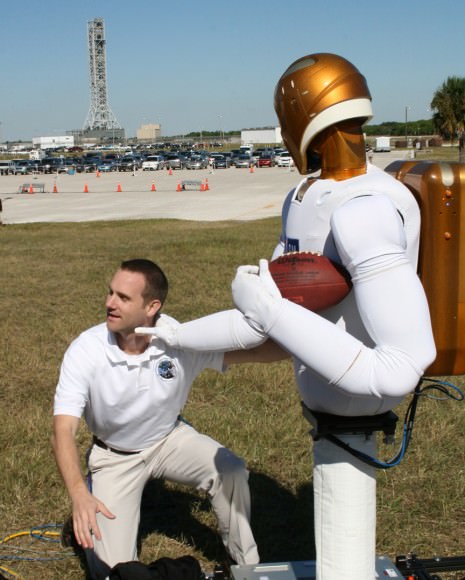
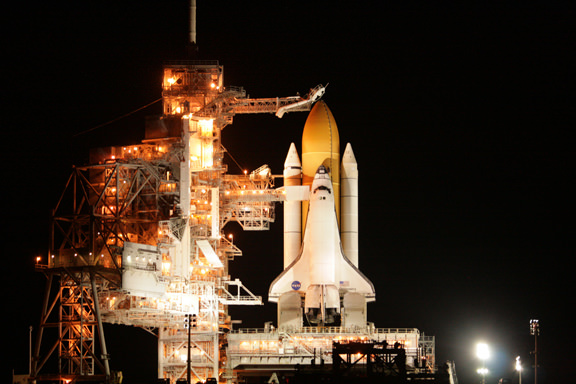
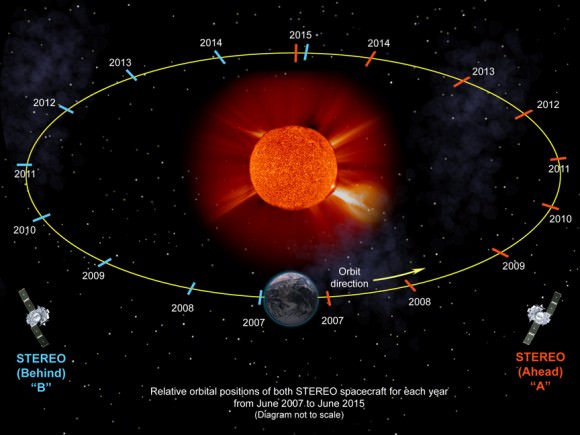
will see the entire Sun for the first time! Credit: NASA.

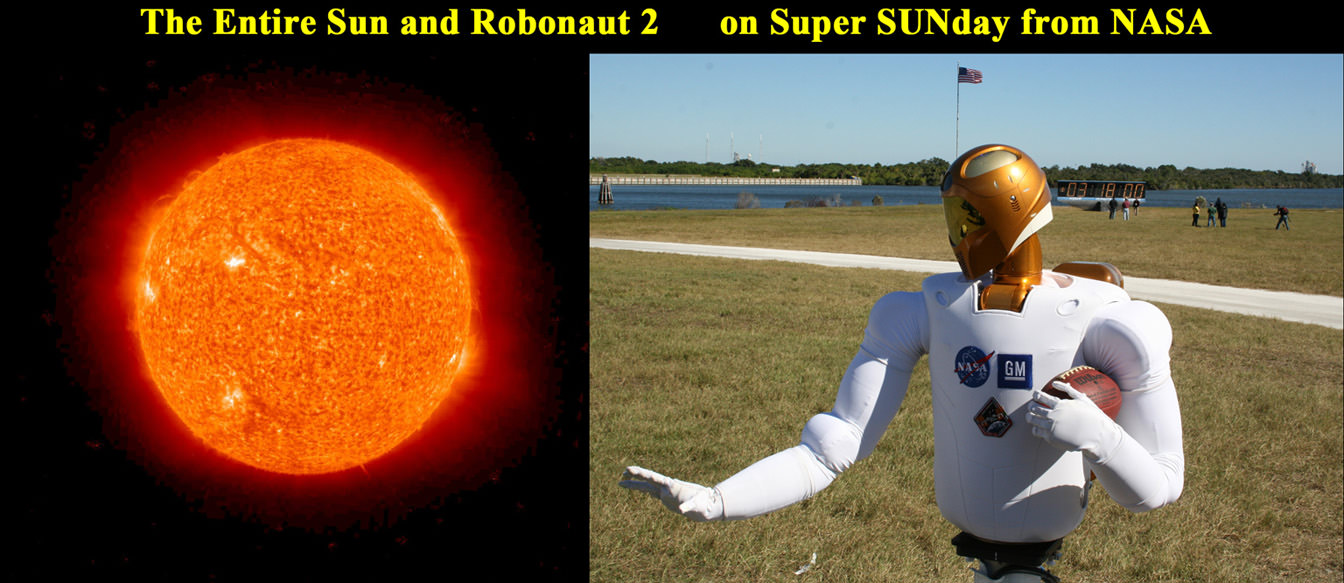
Is Robonaut going to throw the football? Nice tight spiral?
6 foot tall bags of water and minerals are better.
R2 has no lower half, yet weighs 300lbs. IMHO this is yet another case in the world’s space program of throwing good money after bad. It will cost a mint to get him up there, in money and pollution, just so he can tool around with a Rubik cube or some such, giving engineers data they could have got in the lab.
The space/astronaut program is now degenerate – thank goodness for Planck, Herschel, Hubble, SDO etc., drawing attention away from this zero gravity nonsense.
They will put him on wheels. 😀
Seriously though, R2 admits several platforms including wheels:
“Initially R2 will be deployed on a fixed pedestal inside the ISS. Next steps include a leg for climbing through the corridors of the Space Station, upgrades for R2 to go outside into the vacuum of space, and then future lower bodies like legs and wheels to propel the R2 across Lunar and Martian terrain. A four wheeled rover called Centaur 2 is being evaluated at the 2010 Desert Field Test in Arizona as an example of these future lower bodies for R2.”
Lacking a specific lower part is what an engineer call “a feature”.
So? Did you complain 10 times as much last time, the earlier installed “no lower half robot” Dextre weighs in at 3440 lbs?
I’ll call this an improvement!
I also note that the awkward measure really means ~ 140 kg. An EVA astronaut weighs in at ~ 200 kg (~ 115 kg suit). An EVA R2 is nearly as light as an EVA suit (if you discount the mobility ISS arm, which both regularly uses)!
Huh? With that logic I can cherry pick your illogically founded comment and deem the robotic program it is purporting to support as “degenerate”. (It is not of course. Better state the obvious here.)
Rather, “hope R2 should help to motivate kids to study science and space”, is opposite degeneracy. If R2 really will be useful is another matter. But the projected main use AFAIU will be making way for the robotic support that manned or unmanned planetary bases need. Sort of like the beach head ISS provides, so it should fit nicely in the over all strategy.
Of course I mean mass instead of “weigh”. Sorry, I didn’t mean to propagate the dumbosity.
Looks like in 2013 or 2014 we will have cameras 120 degrees apart focused on the sun. We will have Stereo A & B along with SOHO. This will really show us what the sun is doing. Too bad we don’t have a stereo type mission going over the sun’s north and south poles also.
I really love R2D2, but this is not a R2, more a C3.
They might hook it on a PO walking device making it a C3PO.
Why was this robot built to look like a human? Robots should be designed for the tasks they need to accomplish, not what they look like. Why don’t the arms have more joints? Why does it only have two arms, rather than three or four? If the “head” has cameras for controlers on the ground or in the ISS to monitor what the robot is doing, why don’t they have the cameras on an articulating arm to be able to view from various angles or get into tight spaces?
The only reason I can think of why this robot would be designed to look like a human is for public relations purposes.
This type of robot can actually sit in a chair, car,…is more human natural. You do not lose space where an astronaut could be. It is also more natural to control such a thing.
While this form might be overkill, the experience gained will be a lot.
When they colonize the Moon, they might do this with robots like this, land the landers with robots. So the space that is occupied by these robots can later be reused when they use the robots for other stuff.
Yes you are right.
Why is it that when people click on your name, you made sure that we are directed to a website “the costume goddess”?
The only reason I can think of why you did that is public relation purposes.
It’s all about the money.